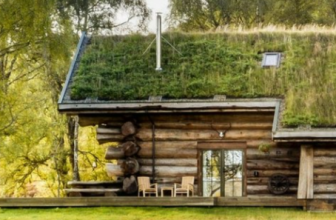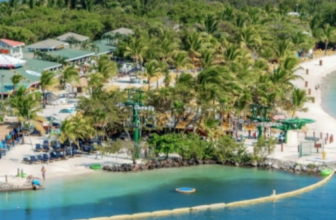Stress-free air time with the new jet set By Suzanne Rowan Kelleher
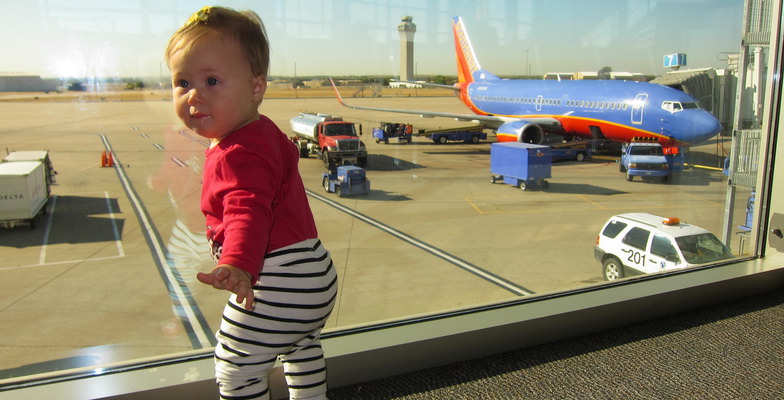 Make airports a pleasant place for your kids. (Flickr: Lars Plougmann)
Make airports a pleasant place for your kids. (Flickr: Lars Plougmann)
Bags packed? Check. E-boarding passes in hand? Double check. Diapers, ear plugs, Ziploc bags, and dry baby food? Got ’em. Congratulations. Flying with a baby will be a thousand times easier because you’re prepared.
For many parents, even the thought of taking a baby on a plane is stressful. And no wonder—air travel can be a hassle even for adults traveling alone. Add a small child to the mix, and there’s suddenly so much more to think about, not to mention so much more to pack.
(MORE: Print a free travel game for the flight.)
Relax. Like everything else you do with your baby in tow, taking a plane trip just requires a bit more planning and some smart streamlining. Luckily, you’ve come to the right place. We’ve assembled a super collection of tried-and-tested tips to make sure your little angel is smiling when she earns her wings.
Book an early flight. Crowd-free airports are happy airports. You can greatly reduce your chances of getting stuck in a congested nightmare if you book a morning take-off. As the day goes on, there’s often a domino effect as one delayed flight bumps back into the next. It’s not surprising, then, that flights scheduled for the afternoon and evening are more likely delayed. The exception to the rule: If you’re looking down the barrel of a long transcontinental or intercontinental flight, consider jumping on a red-eye so your kids can sleep onboard.
Decide how baby will travel. You’ll have to decide for yourself whether to spring for a ticket for your baby or toddler. Major airlines let babies under 2 fly for free on a parent’s lap, though the FAA strongly recommends that each child have his own seat. Typically, an infant fare for a child under 2 is about half an adult fare. If your baby has her own seat, she’ll also need an FAA-approved restraint such as a car seat or the 5-point CARES harness. (Look for a label with these words: “This restraint is certified for use in motor vehicles and aircraft.”)
If (and only if) you think your infant will sleep for a good chunk of the flight, consider booking your seats in a bulkhead row, where you’ll have more legroom and your baby can catch a few winks in a bassinet that bolts to the dividing wall. The bulkhead row has its drawbacks, however: (1) since you can’t store your carry-on bag under the seat in front of you, you have to keep it in the overhead bin during take-off and landing, and (2) your child can’t stretch out with her head in your lap because the armrests between the bulkhead seats are stationary.
Reader tip: “We have always put our 3-year-old in his car seat on the plane. It solves the need for a seat at our destination and, more importantly, he feels secure in it, it’s familiar, he’s safer, and he’s confined. For him, it’s just like being in the car. We started that the first time we flew with him and he’s never given us a problem since.” –Erica from Maumee, OH
Save time and money online. The price of choosing a paper ticket is skyrocketing—up to a whopping $75 at United—so it makes sense to print out your own e-tickets for free. It’s also a good idea to print out your own boarding passes, since this lets you avoid the long check-in line at the airport and you can choose your own seats on the plane. All major airlines offer this service. The typical restrictions are: (1) you must be traveling on a domestic route; (2) you must have an e-ticket; and (3) you must log on between 24 hours and one hour before your flight’s departure time. You can then check your bags at a drop-off kiosk at the airport.
Ship ahead, rent, or buy later. Now that every major airline except Southwest is charging a fee for a second checked bag, it can be cheaper to rent baby gear at your destination than to bring it along. Most car rental agencies can provide a car seat (usually about $10 a day; always call ahead to confirm) and family-friendly hotels can provide a crib (sometimes for free but usually for a fee). You might also consider renting baby essentials, such as a crib or high chair, from a specialty outfitter in your destination. Baby’s Away has locations in 29 states, and you’ll find dozens of similar companies in The New Parents Guide’s awesome state-by-state list.
Reader tip: “About 10 days before we flew to Florida, I shipped a box of diapers, wipes, and baby toiletries to myself at our hotel. First, I called our hotel in advance to see if it was okay. When I addressed the box, I wrote my name and then ‘(Guest, Arriving March 9)’ so the hotel staff would know to hold it for me. This worked out great! I was able to travel ultralight with just a minimum of supplies in my hand luggage, and I had all my baby supplies waiting for me when we arrived.” –Noelle from Morrison, NJ
Reader tip: “At our destination, we stop at the first drugstore and buy shampoo, gel, hairspray, and toothpaste. So much easier than carrying or mailing. We leave what little is left for housekeeping staff if they’d like it.” —Nicol from Rochester, NY
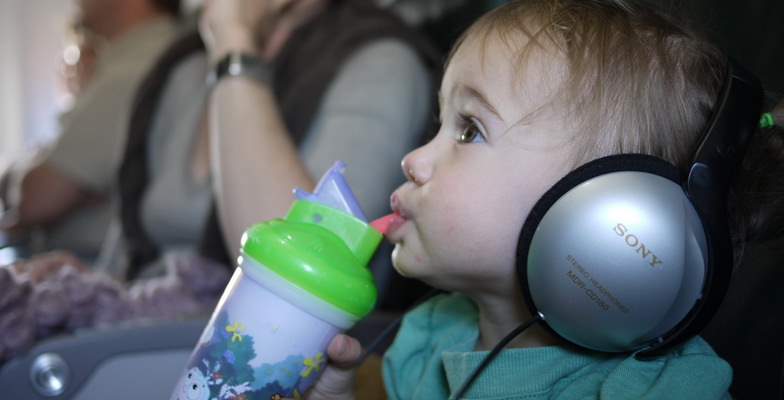 Sippy cups are handy when flying. (Flickr: Greg Glesworth)
Sippy cups are handy when flying. (Flickr: Greg Glesworth)
Think like a Boy Scout. Every major airlines except Southwest now charges for a second checked bag, so you need to think like a scout and streamline your packing. These days, you can’t count on airlines to provide so much as a diaper. What you pack in your carry-on bag needs to get you and your baby from your home to your destination.
Reader tip: “I’ve learned the hard way that it’s important to prepare for delays. To calculate how many diapers, baby wipes, meals, and beverages to bring, I compute the length of our door-to-door journey and add six hours.” –Barbara from Atlanta, GA
Reader tip: “If you’re going to check your child’s car seat, know that (a) it will usually be counted as an extra bag and (b) baggage-handling machines at airports can really rough it up. We used to pack ours in its fabric case until we misplaced it (now we use a duffel bag) and it has never suffered so much as a scratch. As a bonus, we can store an extra supply of baby gear—diapers, wipes, etc.—on the seat in transit.” –Miriam from Glendale, AZ
Reader tip: “When my baby was really tiny and blowing through a dozen diapers a day, we used to get very creative about where we stowed extra diapers in our carry-on bags. They were small, easy to tuck into spare spaces, and cushiony. My husband would use diapers as an extra layer of padding in his laptop case. We used them as extra protection for our electronic gear. For example, I would wrap our digital camera in one diaper and our video camera in another.” –Becca from Providence, RI
Just add water. The TSA’s 3-1-1 rule restricts the amount of liquids and gels you can bring in your carry-on luggage. In addition, you are allowed to bring “reasonable quantities” of baby food, formula, breast milk, and juice for infants and toddlers, but it’s up to security personnel to decide what’s reasonable. If you’ll need to feed your baby on the plane, it’s safest to bring a stash of powdered oatmeal, cereal, and other dry alternatives. Note that the 3-1-1 rule applies to what you bring through security but not to purchases you make on the other side of the checkpoint.
Reader tip: “Once you pass through security, you can purchase bottled water and beverages and bring them on the plane. The last time I flew with my 8-month-old, I brought mainly powdered formula and baby food for the flight. I asked the flight attendants for hot water while we were inflight, and I was prepared to make do with room-temperature water in the airport in a pinch.” –Carly from Topeka, KS
Reader tip: My 9-month-old baby sometimes refuses to take a bottle or a pacifier if he doesn’t want one, so I was worried about the ear pressure bothering him and not being able to help him. I put a clean, dry washcloth in a Ziploc bag and once we got through security, I got some water and poured some on the washcloth. Once we were in the air I gave it to him and he sucked on that and was happy as can be. I’m not sure if it actually helped his ears pop, but he was very happy! –Joelle from Freedom, NY
Bring paperwork. You already know to bring your itinerary, tickets, boarding passes, and either a passport or photo ID. Your child’s birth certificate can come in handy if you need proof of her age or if her last name is not the same as yours.
If you’re a single parent or a grandparent traveling with a minor, you also should bring a consent form signed by the appropriate legal guardians. Forms4Parents lets parents customize legal consent forms to their particular family situation. You can specify travel authority, temporary custodial authority, or medical authority with important information about your child, along with emergency contacts and necessary insurance information.
Reader tip: “Because our son is a tall 20-month-old, we’ve been asked on several occasions at the check-in counter to provide proof of his age. My advice: If your baby is going to travel as a lap baby, be sure to bring a birth certificate. It can make the difference between a fast, streamlined check-in and being forced to purchase a seat for your child.” –Margot from Ann Arbor, MI
Roll with it. Airports are big, busy places and you’ll probably do a lot of walking before you get to your plane. You can wheel your baby in his stroller through the airport and right up to the plane door. Or, if your baby is still light enough, carry him in front of you in an infant carrier.
Reader tip: “When my daughter was an infant, I used to tote her in a baby carrier or a sling. When she got too heavy for the sling, I would wheel her right to the plane door in the lightest umbrella stroller I could find. I’d ask the crew to stow it, and I’d collect it when the plane landed.” –Lindsay from Walla Walla, WA
Crash a VIP party. You don’t need to fly business class or be a frequent flyer to gain admission to airport VIP lounges. If you have a long layover, consider buying your way into a cushy lounge where chairs are comfy, space is ample, TV and wi-fi are available, and food and drinks are free. For as little as $25 a person, Priority Pass and Lounge Pass will let you and your kids gain entry to hundreds of airport clubs around the world. An increasing number of these lounges are now offering designated family rooms; in the United States, these include three of Continental Airlines’ President’s Clubs and nine of American Airlines’ Admirals Clubs. Most lounges allow children under 12 when accompanied by an adult, and there’s sometimes no charge for tots 2 and under, but policies vary so double check before booking.
(MORE: View an oversees trip itinerary: 3 days in Paris, France with kids.)
Board with baby last. If you haven’t flown in a while, here’s a news flash: Airlines have all but done away with pre-boarding for families with children. That’s fine by us. Confining a baby to a small space up to an hour before take-off was never our idea of a smart move. Try this, instead: Have one parent board with as many carry-ons as he can manage. His job is to get your belongings into an overhead bin and the baby’s car seat or CARES harness installed, if you’ve got one. The other parent should play with the baby in the departure lounge until the last possible minute. Then just board and buckle in.
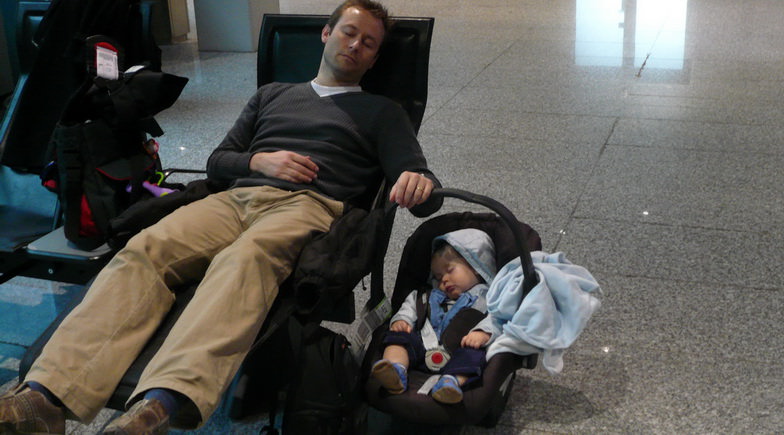 Tip: take a quick nap at the airport. (Flickr: Lars Plougmann)
Tip: take a quick nap at the airport. (Flickr: Lars Plougmann)
Reader tip: “As a professional speaker, I spend many hours in airports. It amazes me how many parents insist that their toddler or preschooler sit in a stroller or a chair waiting for the flight. Since everyone will be constricted on the plane, it’s better to keep active in the airport. My daughter and I like to play the ‘one sip’ game. We walk through the airport from drinking fountain to drinking fountain, taking only one sip at each. The idea is to walk as far as possible with your child. We also always board at the very last moment. Why get on the plane early and have to wait an extra 20 minutes while everyone else boards?” –Silvana from Nashville, TN
Be kind to little ears. Have your child chew, drink, or suck something prior to and during take-offs and landings so pressure changes won’t hurt her ears. For older babies (12 months and up), child-size EarPlanes can work wonders. These silicone ear plugs regulate air pressure inside the ear’s Eustachian tube, relieving the pressure that cause pain. They’re sold at Wal-Mart, Target, and major drugstore chains.
Reader tip: “Whenever we fly, my almost-2-year-old always experiences terrible ear pain when the plane starts its descent before landing. We’ve tried ear plugs, lollipop-sucking, and drinking water—with mixed results. I saw this tip on Cheapflights.com’s family page: ‘Ask the flight attendant to soak a couple of paper napkins in very, very hot water. Wring the napkins out and stick them in the bottom of plastic drink cups. Put the cups over your kids’ ears. It creates a vacuum, and reduces the pressure fast.’ We gave it a try, and it worked like a charm!” –Jean from Beaverton, OR
Be on duty. It’s your job to keep your little one as content and undisruptive to other passengers as possible during the flight. If she cries, stay calm and do what you can to comfort her. If she pitches a tantrum or throws her bottle at the man sleeping behind you, you need to apologize. Some parents break the ice with fellow passengers by handing out pre-emptive ear plugs, but you needn’t go that far. In our experience, most travelers remain friendly and pleasant as long as parents are taking responsibility for their children.
Reader tip: “On long flights, I keep my 13-month-old son busy with small, inexpensive toys that I’ve bought at the dollar store or borrowed from friends. I keep them all hidden in my carry-on bag, then produce them, one at a time, in 20 or 30 minute intervals. A new item keeps him happily occupied and quiet longer than one he already has seen. We also go for short walks on the plane once the ‘fasten your seatbelt’ sign goes off.” –Gwen from Chatham, NY
Reader tip: “It’s truly amazing what will keep a baby entertained. I always bring a stash of books and toys for my baby to play with on a flight, but she will eventually get bored. As we passed through the airport on our last trip, I grabbed a bunch of miscellaneous stuff from the airport cafeteria—six drinking straws, a handful of popsicle stick-like coffee stirrers, and four plastic spoons. When my 11-month-old got bored with all the toys I’d packed, I gave her the cafeteria items along with two plastic cups and a few ice cubes (requested from the flight attendant). That kept her busy for half an hour as she pretended to eat and drink. Afterward, my husband twisted the straws into fun shapes, which bought us another 20 minutes.” –Rachael from Cedar Park, TX
Buy friendships. Even the most laid-back babies cry and put up a stink from time to time. When it happens at 30,000 feet, parents can feel pressure to quiet their child quickly to appease fellow passengers. Our advice: Never mind what strangers think and focus on your baby. In general, people tend to be understanding when they see parents doing what they can to quell a tantrum or calm a crying child.
If you’re still worried about that your baby will be disruptive, try this pre-emptive gesture: At the beginning of the flight, consider handing out small goody bags to passengers in your immediate vicinity. Suggested items include gum or candy, individual-sized bottles of moisturizing lotion, and an all-important set of ear plugs.
Reader tip: On a recent flight, my baby had a crying jag that went on for quite some time. The passengers sitting around me were very understanding, probably because they could see that I was trying my best to quiet her down. In my experience, your fellow passengers just want to see that you’re taking charge of your child. Eventually, she fell asleep and all was quiet. At the end of the flight, I apologized and handed out a few Starbuck’s gift cards ($5). I didn’t feel like I owed them that, but I just wanted to make a nice gesture. I’m going to bring gift cards with me every time I travel from now on. –Janet from Northbrook, IL
Keep some things private. If you need to change your baby’s diaper on the plane, do it on the flip-down table in the lavatory. Space is tight, so bring in just what you need and don’t forget to seal the dirty diaper in a deodorized bag or zip-top bag before disposing of it.
Bring a change of clothes. Show us a baby who’s a frequent flyer, and we’ll show you a parent who’s been barfed and spit up on. It happens. Pack a complete change of baby clothes in a one-gallon zip-top bag. In case of an accident, you’ll not only have clean replacement duds but a place to put the dirties. Give yourself 10 bonus points for including at least a clean tee-shirt for yourself.


